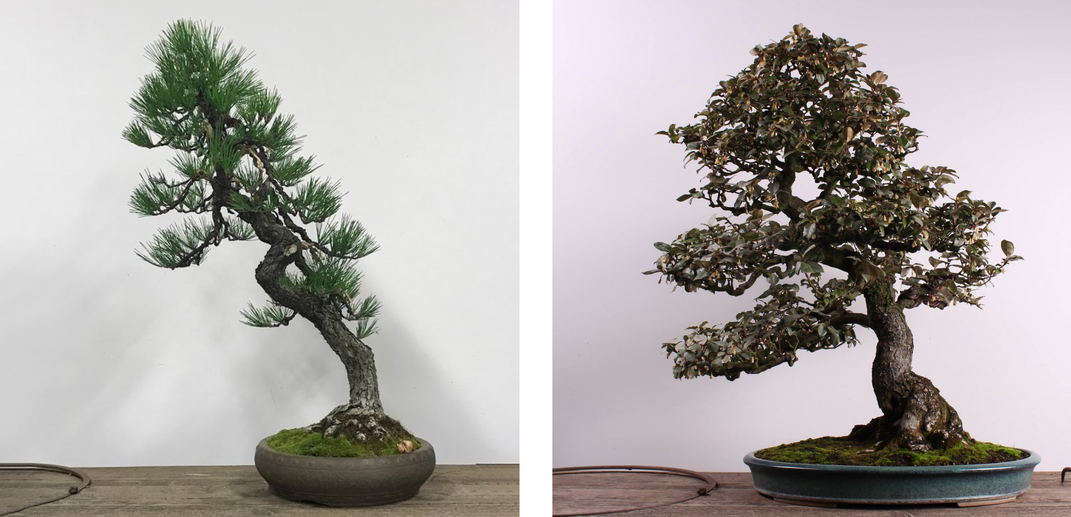Two Stolen Bonsai Trees ‘Mysteriously’ Returned to Washington State Museum
The trees, which have been cultivated for 70-odd years, are in good condition and back on display
/https://tf-cmsv2-smithsonianmag-media.s3.amazonaws.com/filer/b3/22/b322cc76-01ad-4532-8392-7913dc88ecbf/screen_shot_2020-02-12_at_45042_pm.png)
On Sunday morning, a pair of thieves broke into the Pacific Bonsai Museum in Federal Way, Washington, and made off with two historic bonsai trees. Museum staff were devastated—not only because the trees were said to be worth “thousands of dollars,” but also because the bonsai were at risk of dying.
“[T]here is a strong likelihood that the trees will perish,” curator Aarin Packard said in a statement. “These trees have been cared for every day for more than 70 years, and if that daily care doesn’t continue the trees will die.”
The museum put out a call for information, sharing security footage of two hooded figures skulking into a secure exhibit. The institution simply wanted the trees returned, according to the statement, “no questions asked.”
Fortunately, the case of the missing bonsai came to a happy end on Tuesday night, when the trees were “mysteriously” returned to the museum, staff revealed. At around 11 p.m., security guards noticed the bonsai sitting on a road leading up to the institution. They notified the staff, and the police were contacted. Though one of the trees sustained some damage, the bonsai were in overall good condition and were put back on display by Wednesday afternoon.

Bonsai are regular trees and shrubs that, through a meticulous training system, are dwarfed to grow in small containers. The ancient art of cultivating miniature landscapes has roots in China, where it was known as penjing or penzai. Buddhist monks from China may have brought penjing with them when they travelled to Japan and, by the 13th century, the practice was a favorite pastime of the Japanese aristocracy and samurai. Japanese growers developed their own styles, often focusing on single tree displays rather than tiny landscapes. “Bonsai,” a Japanese term meaning “planted in a container,” was first applied to the artform in the 1800s.
Both of the trees stolen from the Pacific Bonsai Museum boast a rich history. One, a Japanese Black Pine, had been grown in a tin can by a Japanese American named Juzaburo Furuzawa while he was incarcerated in a Utah internment camp during WWII.
"I'm not familiar with any other tree that exists in the United States that can trace its provenance to being germinated in an internment camp during the war," Packard tells NPR’s James Doubek.
The other tree is a Silverberry that the California bonsai artist Kiyoko Hatanaka began cultivating in 1946. Silverberry is a common bonsai species in Japan—less so in the United States, according to NPR—but this particular specimen is notable because it was grown by a woman.
"Bonsai's predominantly been a male activity, at least in Japanese culture where ikebana, the Japanese art of flower arranging, was sort of what the women would practice,” Packard explains. “And so for a woman to be doing bonsai in the late '40s or mid-'40s is also rare.”
Bonsai are delicate trees that require continuous and expert care. They should be kept outside unless they are tropical species, but during the colder seasons, staff at the Pacific Bonsai Museum keep their collections alive by covering them and warming them with individual heaters, CNN’s Christina Zdanowicz reports. The trees also need to be watered year-round.
“They can have a turn in their health pretty quickly,” Kathy McCabe, the museum’s executive director, tells the publication.
In the wake of its return, the stolen Silverberry was found to have suffered some broken branches, “probably due to improper transportation and handling,” according to the museum. But overall, both bonsai were in good condition. It is not known who took them, or who returned them. For now, staff members are simply glad to have the trees back.
“The bonsai will be back on public display by 12:00 noon today,” the museum wrote on its Instagram page on Wednesday. “COME VISIT them!”